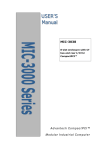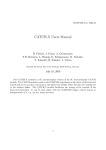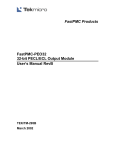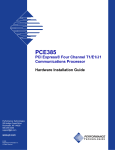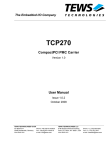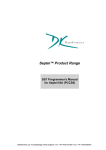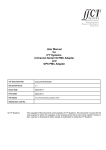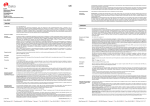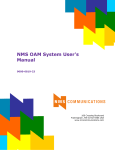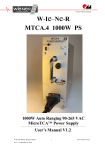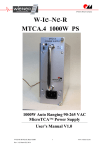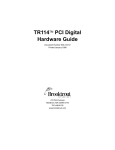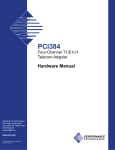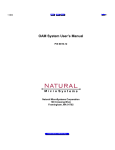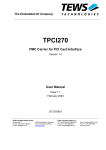Download NCPCI-PMC_manual
Transcript
NcPCI PMC – Technical Reference Manual NcPCI PMC cPCI Carrier for 2 PMC Modules for Telecom Applications Technical Reference Manual V2.2 Hardware Revision V2.0 NcPCI PMC – Technical Reference Manual The NcPCI PMC has been designed by: N.A.T. GmbH Kamillenweg 22 D-53757 Sankt Augustin Phone: ++49/2241/3989-0 Fax: ++49/2241/3989-10 E-Mail: [email protected] Internet: http://www.nateurope.com Version 2.2 © N.A.T. GmbH 2 NcPCI PMC – Technical Reference Manual Disclaimer The following documentation, compiled by N.A.T. GmbH (henceforth called N.A.T.), represents the current status of the product´s development. The documentation is updated on a regular basis. Any changes which might ensue, including those necessitated by updated specifications, are considered in the latest version of this documentation. N.A.T. is under no obligation to notify any person, organization, or institution of such changes or to make these changes public in any other way. We must caution you, that this publication could include technical inaccuracies or typographical errors. N.A.T. offers no warranty, either expressed or implied, for the contents of this documentation or for the product described therein, including but not limited to the warranties of merchantability or the fitness of the product for any specific purpose. In no event will N.A.T. be liable for any loss of data or for errors in data utilization or processing resulting from the use of this product or the documentation. In particular, N.A.T. will not be responsible for any direct or indirect damages (including lost profits, lost savings, delays or interruptions in the flow of business activities, including but not limited to, special, incidental, consequential, or other similar damages) arising out of the use of or inability to use this product or the associated documentation, even if N.A.T. or any authorized N.A.T. representative has been advised of the possibility of such damages. The use of registered names, trademarks, etc. in this publication does not imply, even in the absence of a specific statement, that such names are exempt from the relevant protective laws and regulations (patent laws, trade mark laws, etc.) and therefore free for general use. In no case does N.A.T. guarantee that the information given in this documentation is free of such third-party rights. Neither this documentation nor any part thereof may be copied, translated, or reduced to any electronic medium or machine form without the prior written consent from N.A.T. GmbH. This product (and the associated documentation) is governed by the N.A.T. General Conditions and Terms of Delivery and Payment. Note: The release of the Hardware Manual is related to a certain HW board revision given in the document title. For HW revisions earlier than the one given in the document title please contact N.A.T. for the corresponding older Hardware Manual release. Version 2.2 © N.A.T. GmbH 3 NcPCI PMC – Technical Reference Manual Table of Contents TABLE OF CONTENTS...................................................................................................................................... 4 LIST OF FIGURES .............................................................................................................................................. 6 LIST OF TABLES ................................................................................................................................................ 7 CONVENTIONS................................................................................................................................................... 8 1 INTRODUCTION ....................................................................................................................................... 9 1.1 1.2 2 BOARD FEATURES .............................................................................................................................. 10 BOARD SPECIFICATION ....................................................................................................................... 11 INSTALLATION ...................................................................................................................................... 12 2.1 SAFETY NOTE ..................................................................................................................................... 12 2.2 INSTALLATION PREREQUISITES AND REQUIREMENTS ......................................................................... 13 2.2.1 Requirements................................................................................................................................. 13 2.2.2 Power supply................................................................................................................................. 13 2.2.3 Automatic Power Up ..................................................................................................................... 13 2.3 STATEMENT ON ENVIRONMENTAL PROTECTION ................................................................................. 14 2.3.1 Compliance to RoHS Directive ..................................................................................................... 14 2.3.2 Compliance to WEEE Directive .................................................................................................... 14 2.3.3 Compliance to CE Directive ......................................................................................................... 15 2.3.4 Product Safety ............................................................................................................................... 15 3 LOCATION OVERVIEW........................................................................................................................ 16 4 TDM BUS AND H.110 BUS CONTROLLER ........................................................................................ 17 5 HARDWARE............................................................................................................................................. 18 5.1 5.2 5.3 5.4 5.5 5.6 5.6.1 5.6.2 5.7 5.7.1 5.7.2 5.8 5.8.1 5.8.2 5.8.3 5.8.4 5.8.5 5.8.6 5.8.7 5.8.8 MEMORY MAP (PCI) .......................................................................................................................... 18 MEMORY MAP (LOCAL) ...................................................................................................................... 18 INTERRUPT STRUCTURE ...................................................................................................................... 18 HOT SWAP CAPABILITY ...................................................................................................................... 19 CLOCKING .......................................................................................................................................... 19 RESET STRATEGY .............................................................................................................................. 19 Reset Sources ................................................................................................................................ 19 Reset of the PCI Bus..................................................................................................................... 19 MINIBRIDGES ...................................................................................................................................... 20 Minibridge of the i21555 PCI Bridge............................................................................................ 20 Minibridge of the T8110 H.110 TSI Controller............................................................................. 20 CONTROL / STATUS REGISTERS .......................................................................................................... 21 Interrupt Status Register 1 ............................................................................................................ 21 Interrupt Status Register 2 ............................................................................................................ 21 Interrupt Mask Control / Status Register 1 ................................................................................... 22 Interrupt Mask Control / Status Register 2 ................................................................................... 22 Status Register 1............................................................................................................................ 23 Status Register 2............................................................................................................................ 23 Status Register 3............................................................................................................................ 24 Control / Status Register 4 ........................................................................................................... 24 5.8.8.1 5.8.8.2 Version 2.2 H.110 Clock/Frame Enable Configuration Pins .................................................................................. 25 PMC Module BUSMODEx Configuration Pins.................................................................................. 25 © N.A.T. GmbH 4 NcPCI PMC – Technical Reference Manual 5.8.8.3 TDM Bus Routing Switch Configuration Pin...................................................................................... 25 5.8.9 Control / Status Register 5 ........................................................................................................... 26 5.8.10 Lattice Revision Status Register ............................................................................................... 27 5.8.11 Board Hardware Revision Status Register ............................................................................... 27 5.9 PORT PIN ASSIGNMENT OF THE PERIPHERAL DEVICES........................................................................ 28 5.9.1 Port Pins of the T8110 H.110 TSI Controller ............................................................................... 28 6 CONNECTORS......................................................................................................................................... 29 6.1 6.2 6.3 6.4 6.5 6.5.1 6.5.2 6.5.3 6.5.4 6.5.5 6.5.6 6.5.7 6.5.8 6.6 6.6.1 6.6.2 6.6.3 7 CONNECTOR AND JUMPER OVERVIEW ................................................................................................ 29 CONNECTOR JP2: FRONT PANEL EJECTOR SWITCH ............................................................................ 30 CONNECTOR JP3: JTAG CHAIN OF ONBOARD DEVICES ...................................................................... 30 CONNECTOR JP4: CPLD PROGRAMMING PORT .................................................................................. 30 PMC SLOT 1 CONNECTORS ................................................................................................................ 31 PMC Slot 1 Connector P11........................................................................................................... 31 PMC Slot 1 Connector P12........................................................................................................... 32 PMC Slot 1 Connector P13........................................................................................................... 33 PMC Slot 1 Connector P14 ( PMC 1 I/O ).................................................................................. 34 PMC Slot 2 Connector P21........................................................................................................... 35 PMC Slot 2 Connector P22........................................................................................................... 36 PMC Slot 2 Connector P23........................................................................................................... 37 PMC Slot 2 Connector P24 ( PMC 2 I/O ).................................................................................. 38 COMPACT PCI BACKPLANE CONNECTORS ......................................................................................... 39 Compact PCI Backplane Connector J1......................................................................................... 39 Compact PCI Backplane Connector J2......................................................................................... 41 Compact PCI Backplane Connector J4......................................................................................... 43 NCPCI PMC PROGRAMMING NOTES............................................................................................... 45 7.1 PROGRAMMING THE PCI BRIDGES ...................................................................................................... 45 7.1.1 Intel 21555 Bridge Programming ................................................................................................. 45 7.1.1.1 7.1.1.2 Intel 21555 Power-Up Configuration .................................................................................................. 45 Intel 21555 Configuration by EEPROM Load .................................................................................... 45 7.2 PROGRAMMING THE H.110 TSI CONTROLLER .................................................................................... 46 7.2.1 T8110 Configuration by EEPROM Load ...................................................................................... 46 7.2.2 T8110 local TDM bus Programming Examples ............................................................................ 46 7.2.2.1 7.2.2.2 8 T8110 connected to 2 PMCs with private SCbuses............................................................................. 46 T8110 connected to 2 PMCs with a shared SCbus .............................................................................. 48 KNOWN BUGS AND RESTRICTIONS................................................................................................. 49 APPENDIX A: REFERENCE DOCUMENTATION...................................................................................... 50 APPENDIX B: DOCUMENT’S HISTORY...................................................................................................... 51 Version 2.2 © N.A.T. GmbH 5 NcPCI PMC – Technical Reference Manual List of Figures Figure 1: Figure 2: Figure 3: Figure 4: Figure 5: Figure 6: Figure 7: Version 2.2 NcPCI PMC cPCI Intelligent Carrier Board for PMC Modules............................ 9 NcPCI PMC Block Diagram ................................................................................ 10 Location Diagram of the NcPCI PMC ................................................................. 16 Local TDM Bus Organisation and Synchronisation ............................................ 17 Connectors and Jumpers of the NcPCI PMC ....................................................... 29 T8110 local TDM bus to private SCbus Routing................................................. 47 T8110 local TDM bus to shared SCbus Routing ................................................. 48 © N.A.T. GmbH 6 NcPCI PMC – Technical Reference Manual List of Tables Table 1: Table 2: Table 3: Table 4: Table 5: Table 6: Table 7: Table 8: Table 9: Table 10: Table 11: Table 12: Table 13: Table 14: Table 15: Table 16: Table 17: Table 18: Table 19: Table 20: Table 21: Table 22: Table 23: Table 24: Table 25: Table 26: Table 27: Table 28: Table 29: Table 30: Table 31: Table 32: Table 33: Table 34: Table 35: Table 36: Version 2.2 List of used abbreviations ...................................................................................... 8 NcPCI PMC Features ........................................................................................... 11 IDSEL Routing for internal PCI Bus ................................................................... 18 local Memory Map ............................................................................................... 18 Interrupt Status Register 1.................................................................................... 21 Interrupt Status Register 2.................................................................................... 21 Interrupt Mask Control / Status Register 1........................................................... 22 Interrupt Control / Status Register 2 .................................................................... 22 Status Register 1................................................................................................... 23 Status Register 2................................................................................................... 23 Status Register 3................................................................................................... 24 Control / Status Register 4 ................................................................................... 24 local TDM Bus routing ........................................................................................ 25 Control / Status Register 4 ................................................................................... 26 Board Hardware Revision Status Register ........................................................... 27 Board Hardware Revision Status Register ........................................................... 27 Port Pins of the T8110 TSI Controller ................................................................. 28 Front Panel Ejector Switch................................................................................... 30 JTAG Chain of onboard Devices ......................................................................... 30 Lattice programming port..................................................................................... 30 PMC Slot 1 Connector P11 .................................................................................. 31 PMC Slot 1 Connector P12 .................................................................................. 32 PMC Slot 1 Connector P13 .................................................................................. 33 PMC Slot 1 Connector P14 .................................................................................. 34 PMC Slot 2 Connector P21 .................................................................................. 35 PMC Slot 2 Connector P22 .................................................................................. 36 PMC Slot 2 Connector P23 .................................................................................. 37 PMC Slot 2 Connector P24 .................................................................................. 38 Compact PCI Backplane Connector J1 Rows A – C ........................................... 39 Compact PCI Backplane Connector J1 Rows D – F............................................ 40 Compact PCI Backplane Connector J2 Rows A – C ........................................... 41 Compact PCI Backplane Connector J2 Rows D – F............................................ 42 Compact PCI Backplane Connector J4 Rows A – C ........................................... 43 Compact PCI Backplane Connector J4 Rows D – F............................................ 44 Intel 21555 Power-Up Configuration................................................................... 45 i21555 EEPROM Configuration .......................................................................... 45 © N.A.T. GmbH 7 NcPCI PMC – Technical Reference Manual Conventions If not otherwise specified, addresses and memory maps are written in hexadecimal notation, identified by 0x. Table 1 gives a list of the abbreviations used in this document: Table 1: List of used abbreviations Abbreviation Description b B CPU DMA E1 Flash H.110 J1 K M Bit, binary byte Central Processing Unit Direct Memory Access 2.048 Mbit G.703 Interface Programmable ROM Time-Slot Interchange Bus 1,544 Mbit G.703 Interface (Japan) kilo (factor 400 in hex, factor 1024 in decimal) mega (factor 10,0000 in hex, factor 1,048,576 in decimal) 1,000,000 Herz Time-Slot Interchange Bus of the SCSA, subset of H.110 bus Signal Computing System Architecture 1,544 Mbit G.703 Interface (USA) Agere H.110 Controller Time Division Multiplex Time Slot Assigner Time Slot Interchange MHz SCbus SCSA T1 T8110 TDM TSA TSI Version 2.2 © N.A.T. GmbH 8 NcPCI PMC – Technical Reference Manual 1 Introduction The NcPCI PMC is a high performance PCI Mezzanine Card carrier board especially suited for Telecom and networking applications. Figure 1: NcPCI PMC cPCI Intelligent Carrier Board for PMC Modules Backplane Connectors H.110 TSI PCI -> PCI Bridge PMC Module PMC Module e.g. NPMC-8266-OC3 (Back View) e.g. NPMC-8280-4E1/T1/J1 (Back View) The NcPCI PMC has the following major features: • • • • • Version 2.2 Intel 21555 PCI – PCI bridge (cPCI bus Æ internal PCI bus 1), 64 bit / 66 MHz cPCI hot-swap - capable cPCI 64 bit / 66 MHz, PCI Rev. 2.2 2 PMC slots, 64 bit / 66 MHz, PCI Rev. 2.2, P1386.1 / Draft 2.4a Agere T8110 TSI controller with H.110 / SCSA bus interface © N.A.T. GmbH 9 NcPCI PMC – Technical Reference Manual Figure 2: NcPCI PMC Block Diagram cPCI P1 PCI 64 bit / 66 MHz PCI 64 bit / 66 MHz 64 Bit PCI to PCI bridge PMC Slot 1 P1 P2 bus P2 P4 local Logic P1 H.110 P4 T8110 H.110 TSI P2 SCSA P4 PMC Slot 2 1.1 Board Features • Interfaces cPCI: The NcPCI PMC includes a 32/64 bit 33/66 MHz Compact PCI bus interface. This is implemented by an Intel i21555 PCI Æ PCI bridge. The cPCI interface supports hot swap. int. PCI: The NcPCI PMC implements a 64 bit / 66 MHz PCI bus, which connects the i21555 PCI Æ PCI bridge to the 2 PMC slots, implemented according to IEEE P1386.1 / Draft 2.4a. int. TDM: The NcPCI PMC implements 2 internal TDM interfaces, one each for every PMC I/O connector. These interfaces have 32-bit TDM data path and comply to H.110 as well as SCSA timing constraints. • I/O H.110: Version 2.2 The NcPCI PMC implements a 32 bit H.110 interface according to PICMG 2.5 R1.0. This is implemented by an Agere T8110 TSI device. This device also sets the interface characteristics for the 2 internal TDM interfaces. © N.A.T. GmbH 10 NcPCI PMC – Technical Reference Manual 1.2 Board Specification Table 2: NcPCI PMC Features Board Format standard 6U Compact PCI board PCI to cPCI bridge i21555 cPCI functions 64 Bit / 66 MHz PCI, hot swap, with H.110 extension PMC 2 PMC slots (64 Bit / 66 MHz) Firmware OK1, VxWorks BSP (on request) Power consumption 3.3V 0.5A typ. 5.0V 0.1A typ. + PMC module supply note: the 3.3V supply of the PMC’s is derived from the 5V of the carrier! Environmental conditions Temperature (operating): Temperature (storage): Humidity: 0°C to +60°C with forced cooling -40°C to +85°C 10 % to 90 % rh noncondensing Standards compliance PCI Rev. 2.2 PICMG 2.5 R1.0 IEEE P1386.1 / Draft 2.4a Version 2.2 © N.A.T. GmbH 11 NcPCI PMC – Technical Reference Manual 2 Installation 2.1 Safety Note To ensure proper functioning of the NcPCI PMC during its usual lifetime take the following precautions before handling the board. CAUTION Electrostatic discharge and incorrect board installation and uninstallation can damage circuits or shorten their lifetime. • Before installing or uninstalling the NcPCI PMC read this installation section • Before installing or uninstalling the NcPCI PMC in a rack: - Check all installed boards and modules for steps that you have to take before turning on or off the power. - Take those steps. - Finally turn on or off the power. • Before touching integrated circuits ensure to take all require precautions for handling electrostatic devices. • Ensure that the NcPCI PMC is connected to the backplane via all cPCI connectors and that the power is available on all cPCI connectors (GND, +5V, +3,3V, +12V, +12V). • When operating the board in areas of strong electromagnetic radiation ensure that the module - is firmly screwed to the rack - and shielded by closed housing Version 2.2 © N.A.T. GmbH 12 NcPCI PMC – Technical Reference Manual 2.2 Installation Prerequisites and Requirements IMPORTANT Before powering up • check this section for installation prerequisites and requirements 2.2.1 Requirements The installation requires only • a carrier board for connecting the NcPCI PMC • power supply 2.2.2 Power supply The power supply for the NcPCI PMC must meet the following specifications: • required for the board: - +3.3V / 0.5A typical - +5V / 0.1A typical • required for optionally mounted PMC modules: - +5V / 6.0A max. - +12V / 1.0A max. - –12V / 1.0A max. Refer to User’s Manuals of the PMC modules for information on their power consumption. The numbers given above are the maximum values, if both PMC slots are populated, and each module draws the maximum current allowed from one supply. The overall maximum power allowed to be drawn by both modules together is 15W according to the PMC spec. The power supply of the NcPCI PMC supports PPMC modules with up to 30W in total for both slots. In order to prevent excessive loading of the +3.3V supply of the NcPCI PMC, the +3.3V supply for the PMC modules is derived from the +5V supply of the NcPCI PMC by onboard switching regulators. 2.2.3 Automatic Power Up In the following situations the NcPCI PMC will automatically be reset and proceed with a normal power up: - The voltage sensor generates a reset • when any of the voltages supervised fall out of ±5% tolerance supervised voltages are: +5V, +3.3V • when the system slot board signals a PCI Reset Version 2.2 © N.A.T. GmbH 13 NcPCI PMC – Technical Reference Manual 2.3 Statement on Environmental Protection 2.3.1 Compliance to RoHS Directive Directive 2002/95/EC of the European Comission on the "Restriction of the use of certain Hazardous Substances in Electrical and Electronic Equipment" (RoHS) predicts that all electrical and electronic equipment being put on the European market after June 30th, 2006 must contain lead, mercury, hexavalent chromium, polybrominated biphenyls (PBB) and polybrominated diphenyl ethers (PBDE) and cadmium in maximum concentration values of 0.1% respective 0.01% by weight in homogenous materials only. As these harzadous substances are currently used with semiconductors, plastics (i.e. semiconductor packages, connectors) and soldering tin any hardware product is affected by the RoHS directive if it does not belong to one of the groups of products exempted from the RoHS directive. Although many of hardware products of N.A.T. are exempted from the RoHS directive it is a declared policy of N.A.T. to provide all products fully compliant to the RoHS directive as soon as possible. For this purpose since January 31st, 2005 N.A.T. is requesting RoHS compliant deliveries from its suppliers. Special attention and care has been payed to the production cycle, so that whereever and whenever possible RoHS components are used with N.A.T. hardware products already. 2.3.2 Compliance to WEEE Directive Directive 2002/95/EC of the European Comission on "Waste Electrical and Electronic Equipment" (WEEE) predicts that every manufacturer of electrical and electronical equipment which is put on the European market has to contribute to the reuse, recycling and other forms of recovery of such waste so as to reduce disposal. Moreover this directive refers to the Directive 2002/95/EC of the European Comission on the "Restriction of the use of certain Hazardous Substances in Electrical and Electronic Equipment" (RoHS). Having its main focus on private persons and households using such electrical and electronic equipment the directive also affects business-to-business relationships. The directive is quite restrictive on how such waste of private persons and households has to be handled by the supplier/manufacturer, however, it allows a greater flexibility in business-to-business relationships. This pays tribute to the fact with industrial use electrical and electronical products are commonly intergrated into larger and more complex envionments or systems that cannot easily be split up again when it comes to their disposal at the end of their life cycles. Version 2.2 © N.A.T. GmbH 14 NcPCI PMC – Technical Reference Manual As N.A.T. products are solely sold to industrial customers, by special arrangement at time of purchase the customer agreed to take the responsibility for a WEEE compliant disposal of the used N.A.T. product. Moreover, all N.A.T. products are marked according to the directive with a crossed out bin to indicate that these products within the European Community must not be disposed with regular waste. If you have any questions on the policy of N.A.T. regarding the Directive 2002/95/EC of the European Comission on the "Restriction of the use of certain Hazardous Substances in Electrical and Electronic Equipment" (RoHS) or the Directive 2002/95/EC of the European Comission on "Waste Electrical and Electronic Equipment" (WEEE) please contact N.A.T. by phone or e-mail. 2.3.3 Compliance to CE Directive Compliance to the CE directive is declared. A ‘CE’ sign can ce found on the PCB. 2.3.4 Product Safety The board complies to EN60950 and UL1950. Version 2.2 © N.A.T. GmbH 15 NcPCI PMC – Technical Reference Manual 3 Location Overview The Figure 3: "Location diagram of the NcPCI PMC" shows the position of the important components. Depending on the board type it might be that the board does not include all components named in the location diagram. Figure 3: Location Diagram of the NcPCI PMC LEDs T8110 H.110 TSA i21555 64 Bit PCI/PCI PMC Slot 1 PMC Slot 2 cPCI connectors Version 2.2 © N.A.T. GmbH 16 NcPCI PMC – Technical Reference Manual 4 TDM Bus and H.110 Bus Controller Signal routing and data flow between the T8110 TSI device and the PMC slot I/O connectors is shown in Figure 4: below. Local TDM Bus Organisation and Synchronisation H. 1 1 0 TDM1 T8110 TSI P M C 1 SCSA Figure 4: TDM2 P M C 2 The TDM data are routed through the T8110 TSI device. Hence, any timeslot switching between H.110 bus and the local TDM buses is possible. The TSI device derives its time base from one of the SREF_8K or NETREF1 signals coming from the PMC modules, or from the H.110 bus. From this input it generates FSYNC and SCLK for the local SCbuses to synchronize to. For detailed information please refer to the Agere T8110 User’s Manual. Version 2.2 © N.A.T. GmbH 17 NcPCI PMC – Technical Reference Manual 5 Hardware 5.1 Memory Map (PCI) All addresses on the internal PCI bus are set up by programming the corresponding address registers of the PCI devices and may be chosen by the user. The following correspondence applies for PCI ADxx lines and IDSEL routing: Table 3: IDSEL Routing for internal PCI Bus Device i21555 PMC slot 1 PMC slot 2 IDSEL none AD31 AD30 Address programmable programmable programmable Function PCI arbiter PMC expansion slot PMC expansion slot 5.2 Memory Map (local) Addresses on the internal local bus (minibridge of the i21555) are to be seen as offset to the minibridge base address programmed for the i21555 PCI bridge device. The following correspondence applies: Table 4: local Memory Map Device T8110 Status/Control registers Address 0x00.0000 0x10.0000 Function H.110 TSI device Status/Control registers (see below) 5.3 Interrupt Structure The different PCI / PMC interrupts are generated by a logical Wired-Or of the interrupt sources of the respective PCI buses. The interrupt sources are readable by status registers. Every interrupt source on the NcPCI PMC is maskable by software. The status of these mask registers is also readable. Refer to chapter 5.8 for a detailed description. Version 2.2 © N.A.T. GmbH 18 NcPCI PMC – Technical Reference Manual 5.4 Hot Swap Capability The NcPCI PMC is assembled with the hot swap feature enabled, and PCI signals are precharged to 1V during board insertion. The hot swap capability of the NcPCI PMC according to PICMG 2.1 R2.0 complies to “Full Hot Swap”. For “High Availability” applications contact N.A.T. for support. 5.5 Clocking The NcPCI-PMC is capable of supporting 33 MHz and 66 MHz PCI busses also in a mixed environment. Which bus frequency is actually selected for either side of the bridge depends on the status of the respective M66EN signal lines. If all PCI devices on the bus support 66 MHz, M66EN will be high. Any device not supporting 66 MHz drives M66EN low, thus forcing the bus to operate at 33 MHz bus speed. 5.6 Reset Strategy 5.6.1 Reset Sources There are 3 Reset sources that influence the NcPCI PMC: - Power-On Reset failure of one or more of the power supplies PCIRST signal of the cPCI bus 5.6.2 Reset of the PCI Bus The i21555 PCI Bridge, which interfaces between the internal PCI bus of the NcPCI PMC and the Compact PCI bus, has 3 Reset pins, which carry special functionalities. P_RST and S_RST_IN are inputs, S_RST is an output. P_RST and S_RST_IN put the device into a well-defined Reset Mode and are functionally identical (wire-ored within the chip). S_RST_IN is not used on the NcPCI PMC; P_RST (connected to PCIRST of internal PCI bus) is generated by a CPLD, if one of the reset sources described in the above chapter becomes active, and if an external cPCI PCIRST is received. Version 2.2 © N.A.T. GmbH 19 NcPCI PMC – Technical Reference Manual 5.7 Minibridges 5.7.1 Minibridge of the i21555 PCI Bridge The Minibridge of the i21555 PCI bridge is used as such. Thus, it has to be programmed for support of the 8-bit peripheral devices connected to it. The connected circuitry serves also for serial load support of EEPROM configuration data and Reset configuration defined by logic pin levels during Reset. 5.7.2 Minibridge of the T8110 H.110 TSI Controller The Minibridge of the T8110 TSI controller is not used as such. It is used as microprocessor interface instead and connects to the i21555 minibridge. In order to write data to the microprocessor interface of the T8110 through the i21555 minibridge, it is necessary to obey to a special software handshake specified for writing to the parallel ROM interface of the i21555. Please refer to the i21555 User’s Manual for further details, or ask N.A.T. for sample code. Version 2.2 © N.A.T. GmbH 20 NcPCI PMC – Technical Reference Manual 5.8 Control / Status Registers The address range of the Control / Status registers decoded by hardware is 16 bytes. Larger address ranges mirror every 16 bytes. 5.8.1 Interrupt Status Register 1 Interrupt Status Register 1 is accessed with address offset 0x0 to the base address programmed in the i21555 Mini Bridge Base Address Register plus the address value given in Table 4: . Table 5: Interrupt Status Register 1 Bit Number Bit 7 Bit 6 Bit 5 Bit 4 Bit 3 Bit 2 Bit 1 Bit 0 Read/Write Reset Status Information Value R R R R R R R R 0 0 0 0 0 0 0 0 PMC slot 2 INTD signal PMC slot 2 INTC signal PMC slot 2 INTB signal PMC slot 2 INTA signal PMC slot 1 INTD signal PMC slot 1 INTC signal PMC slot 1 INTB signal PMC slot 1 INTA signal 5.8.2 Interrupt Status Register 2 Interrupt Status Register 2 is accessed with address offset 0x1 to the base address programmed in the i21555 Mini Bridge Base Address Register plus the address value given in Table 4: . Table 6: Interrupt Status Register 2 Bit Number Bit 7 Bit 6 Bit 5 Bit 4 Bit 3 Bit 2 Bit 1 Bit 0 Version 2.2 Read/Write Reset Status Information Value R R R R R R R R 0 0 0 0 0 0 0 0 not used not used not used not used not used Compact PCI bus INTA signal CLKERRTSI (T8110) SYSERRTSI (T8110) © N.A.T. GmbH 21 NcPCI PMC – Technical Reference Manual 5.8.3 Interrupt Mask Control / Status Register 1 Every interrupt source on the NcPCI PMC is maskable by software. The status of these mask registers is readable anytime. The registers initialize to 0x0 after a reset of the PCI bus. Set a bit to enable an interrupt, clear a bit to mask (disable) an interrupt. Interrupt Mask Control / Status Register 1 is accessed with address offset 0x2 to the base address programmed in the i21555 Mini Bridge Base Address Register, plus the address value given in Table 4: . Table 7: Interrupt Mask Control / Status Register 1 Bit Number Bit 7 Bit 6 Bit 5 Bit 4 Bit 3 Bit 2 Bit 1 Bit 0 5.8.4 Read/Write Reset Status Information / Control Setting Value R/W R/W R/W R/W R/W R/W R/W R/W 0 0 0 0 0 0 0 0 PMC slot 2 INTD signal mask bit PMC slot 2 INTC signal mask bit PMC slot 2 INTB signal mask bit PMC slot 2 INTA signal mask bit PMC slot 1 INTD signal mask bit PMC slot 1 INTC signal mask bit PMC slot 1 INTB signal mask bit PMC slot 1 INTA signal mask bit Interrupt Mask Control / Status Register 2 Interrupt Mask Control / Status Register 2 is accessed with address offset 0x3 to the base address programmed in the i21555 Mini Bridge Base Address Register, plus the address value given in Table 4: . Table 8: Interrupt Control / Status Register 2 Bit Number Bit 7 Bit 6 Bit 5 Bit 4 Bit 3 Bit 2 Bit 1 Bit 0 Version 2.2 Read/Write Reset Status Information / Control Setting Value R R R R R R R/W R/W 0 0 0 0 0 0 0 0 not used not used not used not used not used not used T8110 CLKERR signal mask bit T8110 SYSERR signal mask bit © N.A.T. GmbH 22 NcPCI PMC – Technical Reference Manual 5.8.5 Status Register 1 Status Register 1 is accessed with address offset 0x4 to the base address programmed in the i21555 Mini Bridge Base Address Register, plus the address value given in Table 4: . Table 9: Status Register 1 Bit Number Bit 7 Bit 6 Bit 5 Bit 4 Bit 3 Bit 2 Bit 1 Bit 0 Read/Write Reset Status Information Value R R R R R R R R 0 0 0 0 0 0 0 0 not used not used not used cPCI geographical address bit GA4 cPCI geographical address bit GA3 cPCI geographical address bit GA2 cPCI geographical address bit GA1 cPCI geographical address bit GA0 5.8.6 Status Register 2 Status Register 2 is accessed with address offset 0x5 to the base address programmed in the i21555 Mini Bridge Base Address Register, plus the address value given in Table 4: . Table 10: Status Register 2 Bit Number Bit 7 Bit 6 Bit 5 Bit 4 Bit 3 Bit 2 Bit 1 Bit 0 Version 2.2 Read/Write Reset Status Information Value R R R R R R R R 0 0 0 0 0 0 0 0 not used not used not used cPCI auxiliaury geographical address bit SGA4 cPCI auxiliaury geographical address bit SGA3 cPCI auxiliaury geographical address bit SGA2 cPCI auxiliaury geographical address bit SGA1 cPCI auxiliaury geographical address bit SGA0 © N.A.T. GmbH 23 NcPCI PMC – Technical Reference Manual 5.8.7 Status Register 3 Status Register 3 is accessed with address offset 0x6 to the base address programmed in the i21555 Mini Bridge Base Address Register, plus the address value given in Table 4: . Table 11: Status Register 3 Bit Number Read/Write Reset Status Information Value Bit 7 Bit 6 Bit 5 Bit 4 R R R R 0 0 0 0 Bit 3 R 0 Bit 2 R 0 Bit 1 R 0 Bit 0 R 0 not used not used not used auxiliaury geographical address bit GA4 on cPCI Connector J4 auxiliaury geographical address bit GA3 on cPCI Connector J4 auxiliaury geographical address bit GA2 on cPCI Connector J4 auxiliaury geographical address bit GA1 on cPCI Connector J4 auxiliaury geographical address bit GA0 on cPCI Connector J4 5.8.8 Control / Status Register 4 Control / Status Register 4 is accessed with address offset 0x7 to the base address programmed in the i21555 Mini Bridge Base Address Register, plus the address value given in Table 4: . The register initializes to 0x73 after a power-on reset, if no PMC module is installed. Otherwise, the status of bits 3-2 depend on the module installed. Table 12: Control / Status Register 4 Bit Number Bit 7 Bit 6 Bit 5 Bit 4 Bit 3 Bit 2 Bit 1 Bit 0 Version 2.2 Read/Write Reset Status Information / Control Setting Value R/W R/W R/W R/W R R R/W R/W 0 1 1 1 0 0 1 1 OE_D16/31 TDM Bus routing switch BUSMODE 4 signal BUSMODE 3 signal BUSMODE 2 signal BUSMODE 1 signal of PMC slot 2 BUSMODE 1 signal of PMC slot 1 CTC8B_EN H.110 clock/frame Term. Enable CTC8A_EN H.110 clock/frame Term. Enable © N.A.T. GmbH 24 NcPCI PMC – Technical Reference Manual 5.8.8.1 H.110 Clock/Frame Enable Configuration Pins CTC8B_EN, CTC8A_EN Two bits of Control / Status Register 4 are used to select the 33Ω serial line termination of the C8 clock and frame. If the H.110 controller is clock/sync slave the serial lines have to be terminated according to the H.110 specification. If the H.110 controller is clock/sync master the serial lines must not be terminated. The termination of the clock / frame signal groups A and B that connect T8110 and H.110 bus can be set separately for group A and group B. Setting the respective bit to '1' selects the 33 Ω serial line termination (T8110 is clock/sync slave, default setting). Setting the respective bit to '0' shorts the 33 Ω serial line termination (T8110 is clock/sync master). 5.8.8.2 PMC Module BUSMODEx Configuration Pins BUSMODE0-4 Five bits of Control / Status Register 4 are used to manage the PMC BUSMODEx signals. By this register the BUSMODE2-4 pins on the PMC modules can be set, and the status of all BUSMODE signals of both slots is readable. BUSMODE2 - 4 are bused. 5.8.8.3 TDM Bus Routing Switch Configuration Pin OE_D16/31 This bit sets the way the local TDM buses of the PMC modules are routed to the T8110 TSI controller’s local bus interface. The TDM switching element, which is controlled by OE_D16/31, was introduced due to compatibility reasons to older versions of the NcPCI PMC. By default, this bit is cleared, and the TDM routing is compatible to NcPCI PMC version 1.4 and older. Routing between the local TDM buses of the PMC’s and the T8110 TSI can be programmed as follows by programming OE_D16/31: Table 13: local TDM Bus routing OE_D16/31 PMC 1 local TDM D0-15 ÅÆ T8110 TDM 0 D0-15 1 D0-15 bused Version 2.2 PMC 1 local TDM D16-31 ÅÆ T8110 TDM D16-31 D16-31 bused © N.A.T. GmbH PMC 2 local TDM D0-15 ÅÆ T8110 TDM D16-31 D0-15 bused PMC 2 local TDM D16-31 ÅÆ T8110 TDM D16-31 D16-31 bused 25 NcPCI PMC – Technical Reference Manual OE_D16/31 = 0 is intended to be used with PMCs, which connect to the T8110 TSI with 16 TDM data lines each (like in a classical SCSA application). The N.A.T. NPMC-4E1 is such a module. In order to make use of all 32 TDM data lines of the T8110 for these modules also, the TDM data lines D0 – 15 of PMC2 are swapped onto the TDM data lines D16 – 31. For OE_D16/31 = 1, all 32 TDM data lines of the PMCs are connected to the T8110 TSI, but they are bused. By setting this feature the user may not only distribute the number of TDM data lines from each PMC to the TSI freely, but may also specify a routing between the 2 PMC modules, without interference of the T8110. Hence, for all applications NOT needing the compatibility mode to older NcPCI PMC versions, the setting OE_D16/31 = 1 is preferable. 5.8.9 Control / Status Register 5 Control / Status Register 5 is accessed with address offset 0x8 to the base address programmed in the i21555 Mini Bridge Base Address Register, plus the address value given in Table 4: . Table 14: Control / Status Register 4 Bit Number Bit 7 Bit 6 Bit 5 Bit 4 Bit 3 Bit 2 Bit 1 Bit 0 Read/Write Reset Status Information / Control Setting Value R R R/W R/W R/W R/W R/W R/W 0 0 GA3 GA2 GA1 GA0 0 1 not used not used Slot ID 4 signal of both PMC slots Slot ID 3 signal of both PMC slots Slot ID 2 signal of both PMC slots Slot ID 1 signal of both PMC slots Slot ID 0 signal of PMC slot 2 Slot ID 0 signal of PMC slot 1 This register allows the user to program a unique ID for each PMC module in the system. The ID definition complies to the Slot ID definition of the SCSA bus spec. By default, the upper 4 bits of the PMC ID is copied from the lower 4 bits of the cPCI Slot ID GA0 – GA3 (refer to chapter 5.8.5, Status Register 1). Version 2.2 © N.A.T. GmbH 26 NcPCI PMC – Technical Reference Manual 5.8.10 Lattice Revision Status Register The Lattice Hardware Revision Status Register is accessed with address offset 0xE to the base address programmed in the i21555 Mini Bridge Base Address Register, plus the address value given in Table 4: . Table 15: Board Hardware Revision Status Register Bit Number Bit 7 Bit 6 Bit 5 Bit 4 Bit 3 Bit 2 Bit 1 Bit 0 Read/Write Status Information R R R R R R R R Lattice CPLD revision Lattice CPLD revision Lattice CPLD revision Lattice CPLD revision Lattice CPLD revision Lattice CPLD revision Lattice CPLD revision Lattice CPLD revision 5.8.11 Board Hardware Revision Status Register The Board Hardware Revision Status Register is accessed with address offset 0xF to the base address programmed in the i21555 Mini Bridge Base Address Register, plus the address value given in Table 4: . Table 16: Board Hardware Revision Status Register Bit Number Bit 7 Bit 6 Bit 5 Bit 4 Bit 3 Bit 2 Bit 1 Bit 0 Version 2.2 Read/Write Status Information R R R R R R R R hardware PCB layout revision hardware PCB layout revision hardware PCB layout revision hardware PCB layout revision hardware PCB layout revision hardware PCB layout revision hardware PCB layout revision hardware PCB layout revision © N.A.T. GmbH 27 NcPCI PMC – Technical Reference Manual 5.9 Port Pin Assignment of the Peripheral Devices 5.9.1 Port Pins of the T8110 H.110 TSI Controller The T8110 H.110 Controller supplies an 8-bit parallel port, which is wired to the following control signals: Table 17: Port Pins of the T8110 TSI Controller Port Pin Signal Description GP7 GP6 GP5 GP4 GP3 GP2 GP1 GP0 LED2.4 LED2.3 LED2.2 LED2.1 LED1.4 LED1.3 LED1.2 LED1.1 Front-Panel Led (green) Front-Panel Led (yellow) Front-Panel Led (orange) Front-Panel Led (red) Front-Panel Led (green) Front-Panel Led (yellow) Front-Panel Led (orange) Front-Panel Led (red) A bit value of “0” (logic low level) turns a LED on, a bit value of “1” (logic high level) turns it off. See also Figure 5: for LED locations. Version 2.2 © N.A.T. GmbH 28 NcPCI PMC – Technical Reference Manual 6 Connectors 6.1 Connector and Jumper Overview Figure 5: LED 4 LED 3 1 JP2 1 J P 4 1 Connectors and Jumpers of the NcPCI PMC LED 1 LED 2 J P 3 P13 P14 J1 P11 P12 P23 P24 J2 P21 P22 J4 Please refer to the following tables to look up the pin assignment of the NcPCI PMC. Version 2.2 © N.A.T. GmbH 29 NcPCI PMC – Technical Reference Manual 6.2 Connector JP2: Front Panel Ejector Switch Table 18: Front Panel Ejector Switch Pin No. Signal 1 2 3 Switch Contact nc GND The switch contact of the front panel ejector switch closes to GND, when pressed. Default position is open. 6.3 Connector JP3: JTAG chain of onboard Devices Connector JP3 connects the onboard devices i21555 PCI bridge and T8110 TSI to a TDI – TDO daisy-chain JTAG chain. The device order in the chain is as described above. Table 19: JTAG Chain of onboard Devices Pin No. Signal Signal Pin No. 1 3 5 7 9 TCK TMS TDI TDO /TRST nc GND +3.3V GND nc 2 4 6 8 10 6.4 Connector JP4: CPLD Programming Port Connector JP4 connects the JTAG- or programming-port of the Lattice CPLD devices. The CPLD devices are connected to a TDI – TDO daisy-chain. Table 20: Lattice programming port Version 2.2 Pin No. Signal Signal Pin No. 1 3 5 7 9 TCK TMS TDI TDO /TRST nc GND +3.3V GND /ENABLE 2 4 6 8 10 © N.A.T. GmbH 30 NcPCI PMC – Technical Reference Manual 6.5 PMC Slot 1 Connectors 6.5.1 PMC Slot 1 Connector P11 Table 21: PMC Slot 1 Connector P11 Pin No. PCI-Signal PCI-Signal Pin No. 1 3 5 7 9 11 13 15 17 19 21 23 25 27 29 31 33 35 37 39 41 43 45 47 49 51 53 55 57 59 61 63 -12V /INT A PMC1 /INT C PMC1 +5V PCI_RSV1 3.3Vaux GND /GNT PMC1 +5V AD31 AD22 GND CBE3 AD21 +5V AD17 GND /IRDY +5V /LOCK /SB0 GND AD15 AD11 +5V /CBE0 AD05 GND AD03 AD01 +5V /REQ64 2 4 6 8 10 12 14 16 18 20 22 24 26 28 30 32 34 36 38 40 42 44 46 48 50 52 54 56 58 60 62 64 TCK GND /INT B PMC1 /BUSMODE1 PMC1 /INT D PMC1 GND CLK PMC1 GND /REQ PMC1 V (I/O) AD28 AD25 GND AD22 AD19 V (I/O) /FRAME GND /DEVSEL GND /SDONE PAR V (I/O) AD12 AD09 GND AD06 AD04 V (I/O) AD02 AD00 GND Pin 3.3Vaux is not connected to the PMC slot. PCI signals /SDONE, and /SBO are not connected to other components, just pulled high. JTAG signal TCK is pulled low. V(I/O) pins are connected to +3.3V. Version 2.2 © N.A.T. GmbH 31 NcPCI PMC – Technical Reference Manual 6.5.2 PMC Slot 1 Connector P12 Table 22: PMC Slot 1 Connector P12 Pin No. PCI-Signal PCI-Signal Pin No. 1 3 5 7 9 11 13 15 17 19 21 23 25 27 29 31 33 35 37 39 41 43 45 47 49 51 53 55 57 59 61 63 +12V TMS TDI GND PCI_RSV /BUSMODE2 /PCIRST +3.3V /PME PMC1 AD30 GND AD24 IDSEL PMC1 +3.3V AD18 AD16 GND /TRDY GND /PERR +3.3V /CBE1 AD14 M66EN AD08 AD07 +3.3V PCI_RESV PCI_RESV GND ACK64 GND /TRST TDO GND PCI_RSV3 PCI_RSV4 +3.3V /BUSMODE3 /BUSMODE4 GND AD29 AD26 +3.3V AD23 AD20 GND /CBE2 PCI_RESVD +3.3V /STOP GND /SERR GND AD13 AD10 +3.3V PCI_RESV PCI_RESV GND PCI_RESV PCI_RESV +3.3V PCI_RESV 2 4 6 8 10 12 14 16 18 20 22 24 26 28 30 32 34 36 38 40 42 44 46 48 50 52 54 56 58 60 62 64 JTAG signals TMS, TDI, and TDO are not connected to the PMC slot. JTAG signal /TRST is pulled low. Signals labelled xxx PMCx are private for this PMC slot, signals without this attachment are bused to both PMC slots. Version 2.2 © N.A.T. GmbH 32 NcPCI PMC – Technical Reference Manual 6.5.3 PMC Slot 1 Connector P13 Table 23: PMC Slot 1 Connector P13 Pin No. PCI-Signal PCI-Signal Pin No. 1 3 5 7 9 11 13 15 17 19 21 23 25 27 29 31 33 35 37 39 41 43 45 47 49 51 53 55 57 59 61 63 PCI_RESV GND /CBE6 /CBE4 V (I/O) AD63 AD61 GND AD59 AD57 V (I/O) AD55 AD53 GND AD51 AD49 GND AD47 AD45 V (I/O) AD43 AD41 GND AD39 AD37 GND AD35 AD33 V (I/O) PCI_RESV PCI_RESV GND GND /CBE7 /CBE5 GND PAR64 AD62 GND AD60 AD58 GND AD56 AD54 GND AD52 AD50 GND AD48 AD46 GND AD44 AD42 GND AD40 AD38 GND AD36 AD34 GND AD32 PCI_RESV GND PCI_RESV 2 4 6 8 10 12 14 16 18 20 22 24 26 28 30 32 34 36 38 40 42 44 46 48 50 52 54 56 58 60 62 64 V(I/O) pins are connected to +3.3V. Version 2.2 © N.A.T. GmbH 33 NcPCI PMC – Technical Reference Manual 6.5.4 PMC Slot 1 Connector P14 ( PMC 1 I/O ) Table 24: PMC Slot 1 Connector P14 ext. Signal Pin No. PCI-Signal PCI-Signal Pin No. ext. Signal NC CT_D14 CT_D12 CT_D11 CT_D09 CT_D07 CT_D06 CT_D04 CT_D02 GND NC SREF_8K_A GND SL_4 SL_2 SL_0_A NC NC NC NC CT_NETREF1_A NC NC NC NC GND NC NC GND NC NC NC 1 3 5 7 9 11 13 15 17 19 21 23 25 27 29 31 33 35 37 39 41 43 45 47 49 51 53 55 57 59 61 63 Version 2.2 I/O I/O I/O I/O I/O I/O I/O I/O I/O I/O I/O I/O I/O I/O I/O I/O I/O I/O I/O I/O I/O I/O I/O I/O I/O I/O I/O I/O I/O I/O I/O I/O I/O I/O I/O I/O I/O I/O I/O I/O I/O I/O I/O I/O I/O I/O I/O I/O I/O I/O I/O I/O I/O I/O I/O I/O I/O I/O I/O I/O I/O I/O I/O I/O © N.A.T. GmbH 2 4 6 8 10 12 14 16 18 20 22 24 26 28 30 32 34 36 38 40 42 44 46 48 50 52 54 56 58 60 62 64 CT_D15 CT_D13 GND CT_D10 CT_D08 GND CT_D05 CT_D03 CT_D01 CT_D00 /FSYNC_A SCLK_A /SCLKx2_A NC SL_3 SL_1 NC NC NC NC NC GND NC NC NC NC NC NC NC NC NC NC 34 NcPCI PMC – Technical Reference Manual 6.5.5 PMC Slot 2 Connector P21 Table 25: PMC Slot 2 Connector P21 Pin No. PCI-Signal PCI-Signal Pin No. 1 3 5 7 TCK GND /INT B PMC2 /BUSMODE1 PMC2 /INT D PMC2 GND CLK PMC2 GND /REQ PMC2 V (I/O) AD28 AD25 GND AD22 AD19 V (I/O) /FRAME GND /DEVSEL GND /SDONE PAR V (I/O) AD12 AD09 GND AD06 AD04 V (I/O) AD02 AD00 GND -12V /INT A PMC2 /INT C PMC2 +5V 2 4 6 8 PCI_RSV1 3.3Vaux GND /GNT PMC2 +5V AD31 AD22 GND CBE3 AD21 +5V AD17 GND /IRDY +5V /LOCK /SB0 GND AD15 AD11 +5V /CBE0 AD05 GND AD03 AD01 +5V /REQ64 10 12 14 16 18 20 22 24 26 28 30 32 34 36 38 40 42 44 46 48 50 52 54 56 58 60 62 64 9 11 13 15 17 19 21 23 25 27 29 31 33 35 37 39 41 43 45 47 49 51 53 55 57 59 61 63 Pin 3.3Vaux is not connected to the PMC slot. The same applies to PCI signals /SDONE, and /SBO. JTAG signal TCK is pulled low. V(I/O) pins are connected to +3.3V. Version 2.2 © N.A.T. GmbH 35 NcPCI PMC – Technical Reference Manual 6.5.6 PMC Slot 2 Connector P22 Table 26: PMC Slot 2 Connector P22 Pin No. PCI-Signal PCI-Signal Pin No. 1 3 5 7 9 11 13 15 17 19 21 23 25 27 29 31 33 35 37 39 41 43 45 47 49 51 53 55 57 59 61 63 +12V TMS TDI GND PCI_RSV /BUSMODE2 /PCIRST +3.3V /PME PMC2 AD30 GND AD24 IDSEL PMC2 +3.3V AD18 AD16 GND /TRDY GND /PERR +3.3V /CBE1 AD14 M66EN AD08 AD07 +3.3V PCI_RESV PCI_RESV GND ACK64 GND /TRST TDO GND PCI_RSV3 PCI_RSV4 +3.3V /BUSMODE3 /BUSMODE4 GND AD29 AD26 +3.3V AD23 AD20 GND /CBE2 PCI_RESVD +3.3V /STOP GND /SERR GND AD13 AD10 +3.3V PCI_RESV PCI_RESV GND PCI_RESV PCI_RESV +3.3V PCI_RESV 2 4 6 8 10 12 14 16 18 20 22 24 26 28 30 32 34 36 38 40 42 44 46 48 50 52 54 56 58 60 62 64 JTAG signals TMS, TDI, and TDO are not connected to the PMC slot. JTAG signal /TRST is pulled low. Signals labelled xxx PMCx are private for this PMC slot, signals without this attachment are bussed to both PMC slots. Version 2.2 © N.A.T. GmbH 36 NcPCI PMC – Technical Reference Manual 6.5.7 PMC Slot 2 Connector P23 Table 27: PMC Slot 2 Connector P23 Pin No. PCI-Signal PCI-Signal Pin No. 1 3 5 7 9 11 13 15 17 19 21 23 25 27 29 31 33 35 37 39 41 43 45 47 49 51 53 55 57 59 61 63 PCI_RESV GND /CBE6 /CBE4 V (I/O) AD63 AD61 GND AD59 AD57 V (I/O) AD55 AD53 GND AD51 AD49 GND AD47 AD45 V (I/O) AD43 AD41 GND AD39 AD37 GND AD35 AD33 V (I/O) PCI_RESV PCI_RESV GND GND /CBE7 /CBE5 GND PAR64 AD62 GND AD60 AD58 GND AD56 AD54 GND AD52 AD50 GND AD48 AD46 GND AD44 AD42 GND AD40 AD38 GND AD36 AD34 GND AD32 PCI_RESV GND PCI_RESV 2 4 6 8 10 12 14 16 18 20 22 24 26 28 30 32 34 36 38 40 42 44 46 48 50 52 54 56 58 60 62 64 V(I/O) pins are connected to +3.3V. Version 2.2 © N.A.T. GmbH 37 NcPCI PMC – Technical Reference Manual 6.5.8 PMC Slot 2 Connector P24 ( PMC 2 I/O ) Table 28: PMC Slot 2 Connector P24 ext. Signal Pin No. PCI-Signal PCI-Signal Pin No. ext. Signal NC CT_D30 CT_D28 CT_D27 CT_D25 CT_D23 CT_D22 CT_D20 CT_D18 GND NC SREF_8K_B GND SL_4 SL_2 SL_0_B NC NC NC NC CT_NETREF1_B NC NC NC NC GND NC NC GND NC NC NC 1 3 5 7 9 11 13 15 17 19 21 23 25 27 29 31 33 35 37 39 41 43 45 47 49 51 53 55 57 59 61 63 Version 2.2 I/O I/O I/O I/O I/O I/O I/O I/O I/O I/O I/O I/O I/O I/O I/O I/O I/O I/O I/O I/O I/O I/O I/O I/O I/O I/O I/O I/O I/O I/O I/O I/O I/O I/O I/O I/O I/O I/O I/O I/O I/O I/O I/O I/O I/O I/O I/O I/O I/O I/O I/O I/O I/O I/O I/O I/O I/O I/O I/O I/O I/O I/O I/O I/O © N.A.T. GmbH 2 4 6 8 10 12 14 16 18 20 22 24 26 28 30 32 34 36 38 40 42 44 46 48 50 52 54 56 58 60 62 64 CT_D31 CT_D29 GND CT_D26 CT_D24 GND CT_D21 CT_D19 CT_D17 CT_D16 /FSYNC_B SCLK_B /SCLKx2_B NC SL_3 SL_1 NC NC NC NC NC GND NC NC NC NC NC NC NC NC NC NC 38 NcPCI PMC – Technical Reference Manual 6.6 Compact PCI Backplane Connectors The Compact PCI backplane connectors are 5 6-row connectors J1 A – F to J5 A – F. On the NcPCI PMC J3 and J5 are not populated. The 7th row Z does not connect to pins, but is just for shielding and completely connected to GND 6.6.1 Compact PCI Backplane Connector J1 Table 29: Compact PCI Backplane Connector J1 Rows A – C Pin No. 1 2 3 4 5 6 7 8 9 10 11 12 13 14 15 16 17 18 19 20 21 22 23 24 25 Version 2.2 Row A PCI-Signal 5V nc /INTA nc nc /REQ AD30 AD26 /C/BE3 AD21 AD18 Row B PCI-Signal -12V 5V /INTB /HEALTHY nc GND AD29 GND IDSEL GND AD17 Row C PCI-Signal nc nc /INTC V(I/O)_L /RST 3.3V_L AD28 V(I/O) AD23 3.3V AD16 Key Area 3.3V /DEVSEL 3.3V /SERR 3.3V AD12 3.3V AD7 3.3V AD1 5V /FRAME GND nc GND AD15 GND AD9 GND AD4 5V /REQ64 © N.A.T. GmbH /IRDY V(I/O) nc 3.3V AD14 V(I/O)_L AD8 3.3V_L AD3 V(I/O) /ENUM 39 NcPCI PMC – Technical Reference Manual Table 30: Compact PCI Backplane Connector J1 Rows D – F Pin No. 1 2 3 4 5 6 7 8 9 10 11 12 13 14 15 16 17 18 19 20 21 22 23 24 25 Version 2.2 Row D PCI-Signal +12V nc 5V_L INTP GND_L CLK GND_L AD25 GND_L AD20 GND_L Row E PCI-Signal 5V nc /INTD INTS /GNT AD31 AD27 AD24 AD22 AD19 /C/BE2 Row F PCI-Signal GND GND GND GND GND GND GND GND GND GND GND Key Area /BD_SEL /STOP GND_L PAR GND_L AD11 M66EN AD6 5V_L AD0 3.3V /TRDY /LOCK /PERR /C/BE1 AD13 AD10 /C/BE0 AD5 AD2 /ACK64 5V © N.A.T. GmbH GND GND GND GND GND GND GND GND GND GND GND 40 NcPCI PMC – Technical Reference Manual 6.6.2 Compact PCI Backplane Connector J2 Table 31: Compact PCI Backplane Connector J2 Rows A – C Pin No. 1 2 3 4 5 6 7 8 9 10 11 12 13 14 15 16 17 18 19 20 21 22 Version 2.2 Row A PCI-Signal nc nc nc V(I/O) /C/BE5 AD63 AD59 AD56 AD52 AD49 AD45 AD42 AD38 AD35 nc nc nc nc GND nc nc GA4 Row B PCI-Signal GND nc GND nc /64EN AD62 GND AD55 GND AD48 GND AD41 GND AD34 GND nc GND GND GND GND GND GA3 © N.A.T. GmbH Row C PCI-Signal nc nc nc /C/BE7 V(I/O) AD61 V(I/O) AD54 V(I/O) AD47 V(I/O) AD40 V(I/O) AD33 nc nc nc nc nc nc nc GA2 41 NcPCI PMC – Technical Reference Manual Table 32: Compact PCI Backplane Connector J2 Rows D – F Pin No. 1 2 3 4 5 6 7 8 9 10 11 12 13 14 15 16 17 18 19 20 21 22 Version 2.2 Row D PCI-Signal nc nc nc GND /C/BE4 GND AD58 GND AD51 GND AD44 GND AD37 GND nc GND nc GND nc GND nc GA1 Row E PCI-Signal nc nc nc /C/BE6 PAR64 AD60 AD57 AD53 AD50 AD46 AD43 AD39 AD36 AD32 nc nc nc nc nc nc nc GA0 © N.A.T. GmbH Row F PCI-Signal GND GND GND GND GND GND GND GND GND GND GND GND GND GND GND GND GND GND GND GND GND GND 42 NcPCI PMC – Technical Reference Manual 6.6.3 Compact PCI Backplane Connector J4 Compact PCI backplane connector J4 carries the H.110 bus signals. Table 33: Compact PCI Backplane Connector J4 Rows A – C Pin No. 1 2 3 4 5 6 7 8 9 10 11 12 13 14 15 16 17 18 19 20 21 22 23 24 25 Version 2.2 Row A Signal CT_D0 CT_D4 CT_D8 CT_D11 CT_D13 CT_D16 CT_D19 CT_D21 CT_D24 CT_D27 CT_D29 Row B Signal 3.3V CT_D5 CT_D9 5V CT_D14 CT_D17 5V CT_D22 CT_D25 3.3V CT_D30 Row C Signal CT_D1 CT_D6 CT_D10 CT_D12 CT_D15 CT_D18 CT_D20 CT_D23 CT_D26 CT_D28 CT_D31 Key Area nc nc nc nc nc nc nc nc nc GA4_J4 SGA4 nc nc nc nc nc nc nc nc nc GA3_J4 SGA3 © N.A.T. GmbH nc nc nc nc nc nc nc nc /CT_EN GA2_J4 SGA2 43 NcPCI PMC – Technical Reference Manual Table 34: Compact PCI Backplane Connector J4 Rows D – F Pin No. 1 2 3 4 5 6 7 8 9 10 11 12 13 14 15 16 17 18 19 20 21 22 23 24 25 Row D Signal CT_D2 CT_D7 GND 3.3V 3.3V GND GND 5V GND 5V V(I/O) Row E Signal CT_D3 GND SCLKX2 SCLK CT_NETREF2 CT_NETREF1 CT_C8B CT_C8A /FSYNC CT_FRAMEA* CT_FRAMEB* Row F Signal GND GND GND GND GND GND GND GND GND GND GND Key Area nc nc nc nc nc nc nc nc nc GA1_J4 SGA1 nc nc nc nc nc nc nc nc nc GA0_J4 SGA0 nc nc nc nc nc nc SGND** SGND** SGND** SGND** SGND** * see chapter 7 on known bugs ** SGND is the protective GND of the board case and shielding, connected also to the front panel. Version 2.2 © N.A.T. GmbH 44 NcPCI PMC – Technical Reference Manual 7 NcPCI PMC Programming Notes 7.1 Programming the PCI Bridges 7.1.1 Intel 21555 Bridge Programming The Intel 21555 Bridge, which bridges between the Compact PCI bus and the internal PCI bus, is initialized by two ways: Power-Up configuration and EEPROM load of setup information on various Reset conditions. 7.1.1.1 Intel 21555 Power-Up Configuration Power-Up configuration is done by pulling the data pins of the ROM interface to specific logic levels during Power-Up Reset. Details are found in the table below. Table 35: Intel 21555 Power-Up Configuration Data bit PR_AD7 PR_AD6 PR_AD5 PR_AD4 PR_AD3 PR_AD2 PR_AD1 Function internal PCI bus central functions PCI arbiter internal PCI bus S_CLK_O Sync Mode Primary Lockout Reset Value none cPCI bus 64 bit enable initialized to enabled enabled disabled asynchronous no lockout pulled high not used* 7.1.1.2 Intel 21555 Configuration by EEPROM Load When reset, the i21555 loads several registers from EEPROM, if available. On the NcPCI PMC, a 93LC66A serial EEPROM is connected to the serial ROM interface of the i21555. The following data is loaded (please consult the i21555 User’s Manual for a detailed description): Table 36: i21555 EEPROM Configuration Serial ROM Address 0x0 0x10 0x20 0x30 0x40 0x50 0x60-0xFF Hex Value 80 00 00 00 00 00 FF 00 00 00 08 40 00 FF 00 00 00 00 00 00 FF 00 00 00 00 FF 00 FF 00 00 00 00 70 00 FF 80 00 00 00 A5 00 FF 06 00 F1 7F 10 00 FF 00 00 1F 7F 00 00 FF 00 00 00 00 02 FF FF 02 00 00 00 06 FF FF 06 00 00 00 00 FF FF 00 00 FF 00 00 FF FF 00 00 00 00 01 FF FF 00 00 00 00 00 FF FF 80 00 00 00 00 FF FF 06 00 FF 00 00 FF FF Data bytes 0x0 – 0x42 are loaded into the i21555 as register setup. Data bytes from 0x44 up are N.A.T. coding of board parameters. Version 2.2 © N.A.T. GmbH 45 NcPCI PMC – Technical Reference Manual 7.2 Programming the H.110 TSI Controller The T8110 H.110 Timeslot Interchange Controller is located on the parallel ROM interface of the i21555 PCI bridge. Some setup information also resides in an EEPROM, which is loaded on Reset. 7.2.1 T8110 Configuration by EEPROM Load The EEPROM connected to the T8110 is delivered empty (default), i.e. it reads 0xFF in all cells. This results in the T8110 ignoring it. Hence, all initialisation has to be done by external software. The user may program the EEPROM according to his needs. 7.2.2 T8110 local TDM bus Programming Examples There are many different applications to which the bidirectional TDM bus between the T8110 TSI and the PMC modules may be adapted. In the following paragraphs, two possible and common applications are described, and the settings necessary for them. The first example describes the connection to classical SCSA modules, i.e. with a SC4000 TSI device with 16 TDM data lines. Transmit and Receive data paths are set to be 8 bits wide each. The second example describes the connection to modules with H.110 interface, i.e. with a CT812 TSI device with 32 TDM data lines. Due to compatibility reasons, SCbus protocol and control signal set is used, but the data bus is extended to 32 bits, in order to support H.110 standards. Transmit and Receive data paths are not restricted in use, and may be specified according to the user’s needs. 7.2.2.1 T8110 connected to 2 PMCs with private SCbuses The local TDM bus of the T8110 TSI has to be programmed to behave as an SCbus with clock master functionality, both PMC modules are supposed to be SCbus clock slaves, in order to achieve synchronisation. This is achieved by the following routing of T8110 local TDM signals to the SCbuses of the 2 PMC slots: Version 2.2 © N.A.T. GmbH 46 NcPCI PMC – Technical Reference Manual - T8110 TDM_D0-7 writes timeslot data to SCbus D0-7 of PMC module 1 T8110 TDM_D16-23 writes timeslot data to SCbus D0-7 of PMC module 2 - PMC module 1 SCbus D8-15 writes timeslot data to T8110 TDM_D8-15 PMC module 2 SCbus D8-15 writes timeslot data to T8110 TDM_D24-31 - T8110 local clock output LSC0 drives SCbus signal SCLK to PMC module 1 T8110 local clock output LSC1 drives SCbus signal /SCLKx2 to PMC module 1 T8110 local sync output FG0 drives SCbus signal /FSYNC to PMC module 1 - T8110 local clock output LSC2 drives SCbus signal SCLK to PMC module 2 T8110 local clock output LSC3 drives SCbus signal /SCLKx2 to PMC module 2 T8110 local sync output FG1 drives SCbus signal /FSYNC to PMC module 2 - PMC module 1 drives SCbus signal SREF_8K to T8110 LREF0 input PMC module 2 drives SCbus signal SREF_8K to T8110 LREF1 input PMC module 1 drives H.110 signal NETREF1_A to T8110 LREF2 input PMC module 2 drives H.110 signal NETREF1_B to T8110 LREF3 input Figure 6: shows the local TDM bus and SCbus routing between T8110 and the PMC modules: Figure 6: T8110 local TDM bus to private SCbus Routing SREF_8K SCbus D0-7 PMC1 SCbus D8-15 T8110 TSI SCLK, SCLKX2, FSYNC SCbus D0-7 PMC2 SCbus D8-15 SREF_8K Version 2.2 © N.A.T. GmbH 47 NcPCI PMC – Technical Reference Manual 7.2.2.2 T8110 connected to 2 PMCs with a shared SCbus The local TDM bus of the T8110 TSI has to be programmed to behave as an SCbus with clock master functionality, both PMC modules are supposed to be SCbus clock slaves, in order to achieve synchronisation. The routing of TDM data is not restricted. Please take into account that the bus is shared by the 2 PMC slots. - T8110 local clock output LSC0 drives SCbus signal SCLK to PMC module 1 T8110 local clock output LSC1 drives SCbus signal /SCLKx2 to PMC module 1 T8110 local sync output FG0 drives SCbus signal /FSYNC to PMC module 1 - T8110 local clock output LSC2 drives SCbus signal SCLK to PMC module 2 T8110 local clock output LSC3 drives SCbus signal /SCLKx2 to PMC module 2 T8110 local sync output FG1 drives SCbus signal /FSYNC to PMC module 2 - PMC module 1 drives SCbus signal SREF_8K to T8110 LREF0 input PMC module 2 drives SCbus signal SREF_8K to T8110 LREF1 input PMC module 1 drives H.110 signal NETREF1_A to T8110 LREF2 input PMC module 2 drives H.110 signal NETREF1_B to T8110 LREF3 input Figure 7: shows the local TDM bus and SCbus routing between T8110 and the PMC modules: Figure 7: T8110 local TDM bus to shared SCbus Routing SREF_8K T8110 TSI SCbus D0-31 PMC1 SCbus D0-31 PMC2 SCbus D0-31 SCLK, SCLKX2, FSYNC SREF_8K Version 2.2 © N.A.T. GmbH 48 NcPCI PMC – Technical Reference Manual 8 Known Bugs and Restrictions In hardware versions Rev. 1.0 – Rev. 1.2 of the NcPCI-PMC the H.110 bus signals FRAME_A and FRAME_B are swapped. As a software workaround enable both A and B signals on the clock master device, then the T8110 on the NcPCI-PMC will always lock correctly, no matter whether it synchronizes to A or B clocks. Fixed in Rev. 1.3 and higher. The Board Hardware Revision Status Register as described in chapter 5.8.11 is available in Rev. 1.3 and higher. The Lattice Revision Status Register as described in chapter5.8.10 is available in Rev. 2.0 and higher. PMC module Slot ID programming as described in chapter 5.8.9 (Control / Status Register 5) is available in Rev. 2.0 and higher. TDM bus routing as described in chapter 5.8.8.3 (TDM Bus Routing Switch Configuration Pin) is available in Rev. 2.0 and higher. Version 2.2 © N.A.T. GmbH 49 NcPCI PMC – Technical Reference Manual Appendix A: Reference Documentation [1] [2] Intel Corp., 21555 Non-Transparent PCI-to-PCI Bridge User Manual, July 2001 Agere Systems, Ambassador T8110 PCI-based H.100/H.110 Switch and Packet Payload Engine, April 2001 Version 2.2 © N.A.T. GmbH 50 NcPCI PMC – Technical Reference Manual Appendix B: Document’s History Revision Date Description Author 1.0 1.1 1.2 1.3 1.4 1.5 1.6 1.7 1.8 1.9 2.0 2.1 2.2 06.01.2003 28.04.2003 05.09.2003 12.09.2003 06.11.2003 07.11.2003 15.12.2003 19.12.2003 02.09.2004 03.05.2005 30.05.2005 28.09.2005 10.02.2006 06.06.2007 initial version corrections chapter 7 Known Bugs added table 31 corrected chapter 6.2 TDM routing information added table 24 TDM signals corrected H.110 FRAME bug description added adapted to HW Rev. 1.2 some amendments, Table 32 adapted chapter 4.8.8 CTC8x_EN description corrected Board Hardware Revision Status Register added adapted to HW Rev. 2.0 ‘Statement on Environmental Protection’ added chapter 2.3.3 and 2.3.4 added ga ga ga ga ga ga ga ga ga ga ga ga ga ga Version 2.2 © N.A.T. GmbH 51



















































